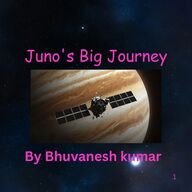
Return to flip book view
Message Juno's Big JourneyBy Bhuvanesh kumar1
Juno is a space robot sent byNASA to study Jupiter, thebiggest planet!2
She launched in 2011 and reachedJupiter in 2016.3
Juno flies around Jupiter, takingpictures and sending back secretsabout its storms, clouds, andstrange center.4
She found:Stroms like the great red spot Beautiful lights called auroras Jupiter has a soft middle and tinyrings1.2.3.
One day, Juno will dive intoJupiter. But her discoveries willhelp scientists for many years.6
Juno is a real space hero!7THE END